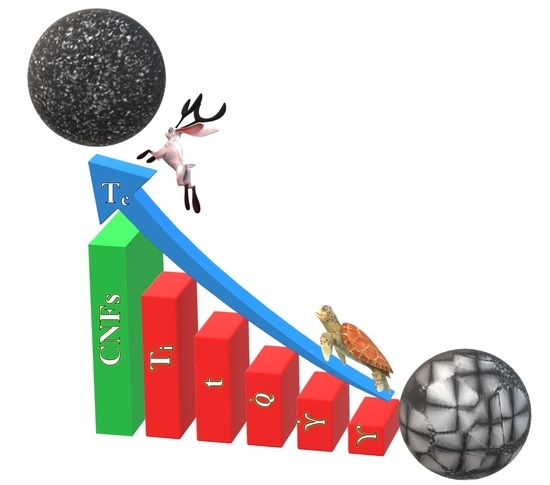Shear-Induced and Nanofiber-Nucleated Crystallization of Novel Aliphatic–Aromatic Copolyesters Delineated for In Situ Generation of Biodegradable Nanocomposites
Abstract
:1. Introduction
2. Experimental
2.1. Materials
2.2. Sample Preparation
2.3. Rheo-Optical Measurements: Shear-Induced Crystallization Test
2.4. Thermal Analysis
3. Results
3.1. Shear-Induced Crystallization under Various Process Conditions
3.1.1. Effect of Shear Rate on Tc
3.1.2. Effect of Shear Rate on Crystal Growth
3.1.3. Effect of Shear Rate on Crystallization Kinetics
3.1.4. Effect of Cooling Rate on Tc
3.1.5. Effects of Shearing Time and Temperature on Tc
3.2. Nanofiber-Nucleated Crystallization of PBAT
3.2.1. Effect of CNFs on Tc
3.2.2. Effect of CNFs on thermal degradation
4. Conclusions
Funding
Institutional Review Board Statement
Informed Consent Statement
Data Availability Statement
Conflicts of Interest
References
- Voznyak, Y.; Morawiec, J.; Galeski, A. Ductility of polylactide composites reinforced with poly (butylene succinate) nanofibers. Compos. A 2016, 90, 218–224. [Google Scholar] [CrossRef]
- Hosseinnezhad, R.; Vozniak, I.; Morawiec, J.; Galeski, A.; Dutkiewicz, S. In situ generation of sustainable PLA-based nanocomposites by shear induced crystallization of nanofibrillar inclusions. RSC Adv. 2019, 9, 30370–30380. [Google Scholar] [CrossRef] [Green Version]
- Kimble, L.D.; Bhattacharyya, D.; Fakirov, S. Biodegradable microfibrillar polymer-polymer composites from poly(L-lactic acid)/poly(glycolic acid). eXPRESS Polym. Let. 2015, 9, 300–307. [Google Scholar] [CrossRef]
- Vozniak, I.; Hosseinnezhad, R.; Morawiec, J.; Galeski, A. Nanofibrillar green composites of polylactide/polyhydroxyalkanoate produced in situ due to shear induced crystallization. Polymers 2019, 11, 1811–1823. [Google Scholar] [CrossRef] [Green Version]
- Yousfi, M.; Dadouche, T.; Chomat, D.; Samuel, C.; Soulestin, J.; Lacrampe, M.F.; Krawczak, P. Development of nanofibrillar morphologies in poly(L-lactide)/poly(amide) blends: Role of the matrix elasticity and identification of the critical shear rate for the nodular/fibrillar transition. RSC Adv. 2018, 8, 22023–22041. [Google Scholar] [CrossRef] [Green Version]
- Hosseinnezhad, R.; Vozniak, I.; Morawiec, J.; Galeski, A. Nanofibrillar green composites of polylactide/polyamide produced in situ due to shear induced crystallization. Compos. Commun. 2020, 22, 100512. [Google Scholar] [CrossRef]
- Vozniak, I.; Hosseinnezhad, R.; Morawiec, J.; Galeski, A. Microstructural evolution of poly(-caprolactone), its immiscible blend, and in situ generated nanocomposites. Polymers 2020, 12, 2587. [Google Scholar] [CrossRef] [PubMed]
- Hosseinnezhad, R.; Vozniak, I.; Morawiec, J.; Galeski, A. Evolution of green in-situ generated polyamide nanofibers controlled by viscoelasticity. eXPRESS Polym. Let. 2021, 15, 250–261. [Google Scholar] [CrossRef]
- Lamberti, G. Flow induced crystallisation of polymers. Chem. Soc. Rev. 2014, 43, 2240–2252. [Google Scholar] [CrossRef] [PubMed]
- Peters, G.W.M.; Balzano, L.; Steenbakkers, R.J.A. Flow-Induced Crystallizatin. In Handbook of Polymer Crystallization; Piorkowska, E., Rutledge, G.C., Eds.; John Wiley & Sons, Inc.: Hoboken, NJ, USA, 2013; pp. 399–432. [Google Scholar]
- Wang, Z.; Ma, Z.; Li, L. Flow-induced crystallization of polymers: Molecular and thermodynamic considerations. Macromolecules 2016, 49, 1505–1517. [Google Scholar] [CrossRef]
- van Meerveld, J.; Peters, G.W.; Hütter, M. Towards a rheological classification of flow induced crystallization experiments of polymer melts. Rheol. Acta 2004, 44, 119–134. [Google Scholar] [CrossRef] [Green Version]
- Mykhaylyk, O.O.; Chambon, P.; Graham, R.S.; Fairclough, J.P.A.; Olmsted, P.D.; Rya, A.J. The specific work of flow as a criterion for orientation in polymer crystallization. Macromolecules 2008, 41, 1901–1904. [Google Scholar] [CrossRef]
- Qiu, S.; Zhou, Y.; Waterhouse, G.I.N.; Gong, R.; Xie, J.; Zhang, K.; Xu, J. Optimizing interfacial adhesion in PBAT/PLA nanocomposite for biodegradable packaging films. Food Chem. 2021, 334, 127487. [Google Scholar] [CrossRef]
- He, L.; Song, F.; Guo, Z.W.; Zhao, X.; Yang, N.; Wang, X.L.; Wang, Y.Z. Toward strong and super-toughened PLA via incorporating a novel fully bio-based copolyester containing cyclic sugar. Compos. Part B Eng. 2021, 207, 108558. [Google Scholar] [CrossRef]
- Zhou, Y.; Qiu, S.; Waterhouse, G.I.N.; Zhang, K.; Xu, J. Enhancing the properties of PBAT/PLA composites with novel phosphorus-based ionic liquid compatibilizers. Mater. Today Commun. 2021, 27, 102407. [Google Scholar] [CrossRef]
- Palai, B.; Mohanty, S.; Nayak, S.K. A Comparison on Biodegradation Behaviour of Polylactic Acid (PLA) Based Blown Films by Incorporating Thermoplasticized Starch (TPS) and Poly (Butylene Succinate-co-Adipate) (PBSA) Biopolymer in Soil. J. Polym. Environ. 2021, 250. [Google Scholar] [CrossRef]
- Palsikowski, P.A.; Kuchnier, C.N.; Pinheiro, I.F.; Morales, A.R. Biodegradation in soil of PLA/PBAT blends compatibilized with chain extender. J. Polym. Environ. 2018, 26, 330–341. [Google Scholar] [CrossRef]
- Shankar, S.; Rhim, J.W. Effect of types of zinc oxide nanoparticles on structural, mechanical, and antibacterial properties of poly (lactide)/poly (butylene adipate-co-terephthalate) composite films. Food Packag. Shelf. Life 2019, 21, 100327. [Google Scholar] [CrossRef]
- Kim, S.M.; Roy, S.; Yoon, K.S.; Rhim, J.W. Preparation of low-density polyethylene- and poly (lactide)/poly (butylene adipate-co-terephthalate)-based antibacterial films integrated with elemental sulfur and sulfur nanoparticles. Packag. Technol. Sci. 2021, 34, 505–516. [Google Scholar] [CrossRef]
- Wojtczak, M.; Dutkiewicz, S.; Galeski, A.; Piorkowska, E. Structure and characterization of random aliphatic–aromatic copolyester. Eur. Polym. J. 2014, 55, 86–97. [Google Scholar] [CrossRef]
- Wojtczak, M.; Dutkiewicz, S.; Pietrzak, L.; Galeski, A.; Piorkowska, E. Nucleation and crystallization of random aliphatic-butylene terephtalate copolyester. Eur. Polym. J. 2015, 71, 289–303. [Google Scholar] [CrossRef]
- Bojda, J.; Piorkowska, E.; Pluta, M. Shear-induced non-isothermal crystallization of poly(butylene adipate-co-terephthalate). Polym. Test. 2020, 85, 106420. [Google Scholar] [CrossRef]
- da Silva, C.G.; Kano, F.S.; Rosa, D.d.S. Thermal stability of the PBAT biofilms with cellulose nanostructures/essential oils for active packaging. J. Therm. Anal. Calorim. 2019, 138, 2375–2386. [Google Scholar] [CrossRef]
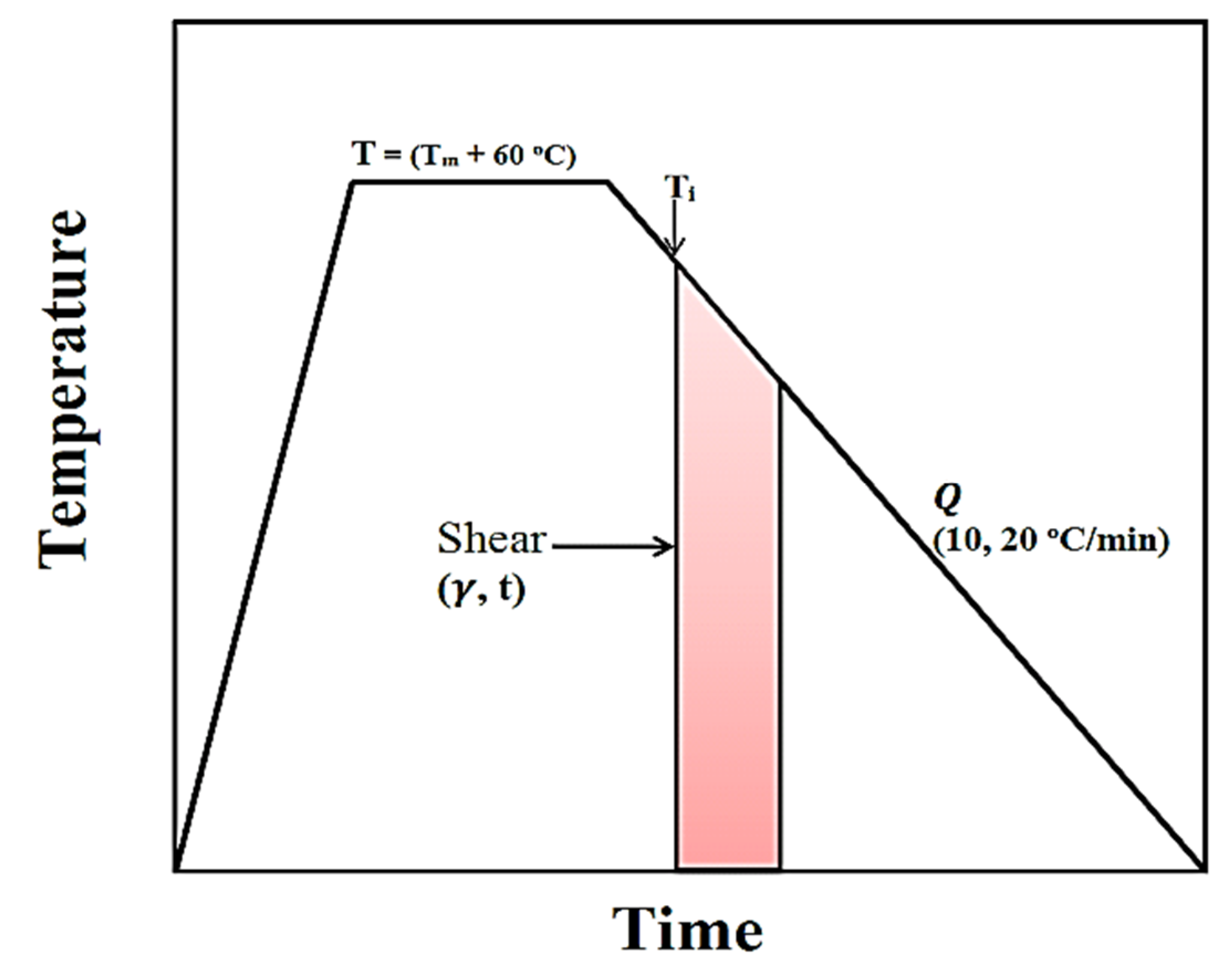
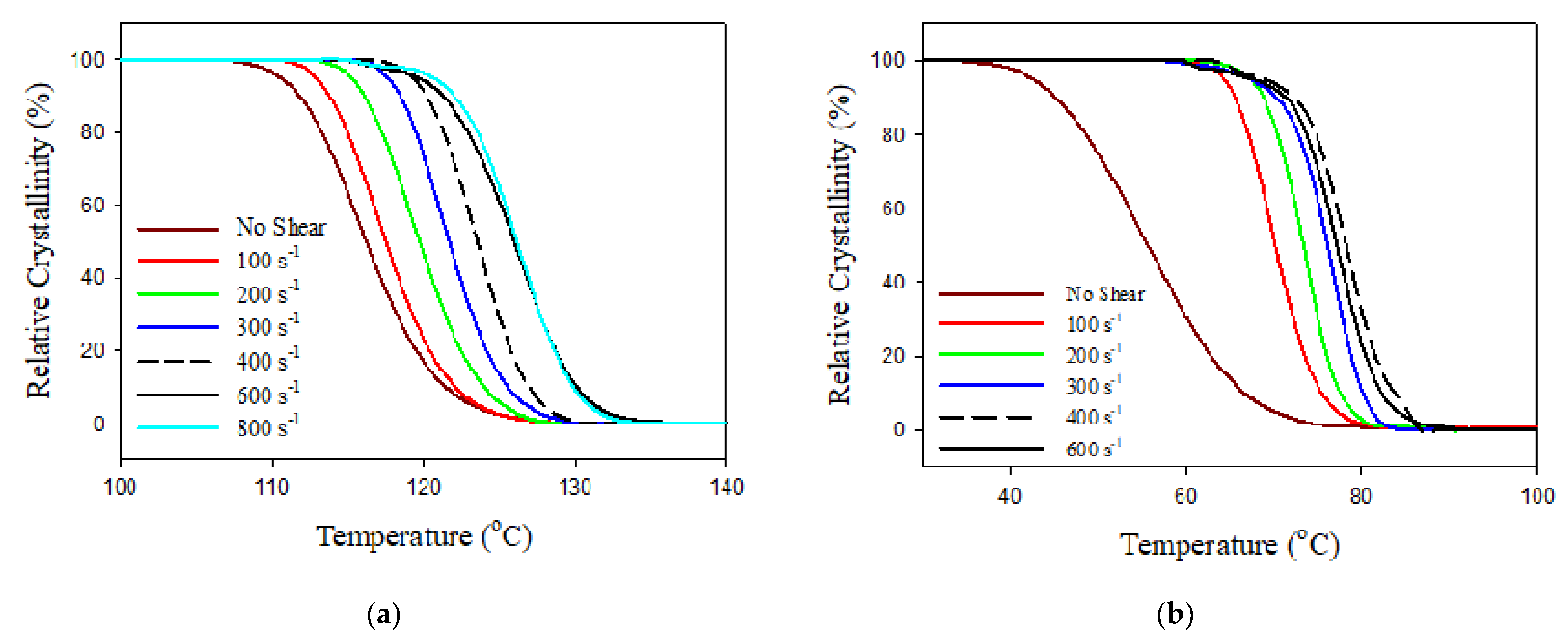

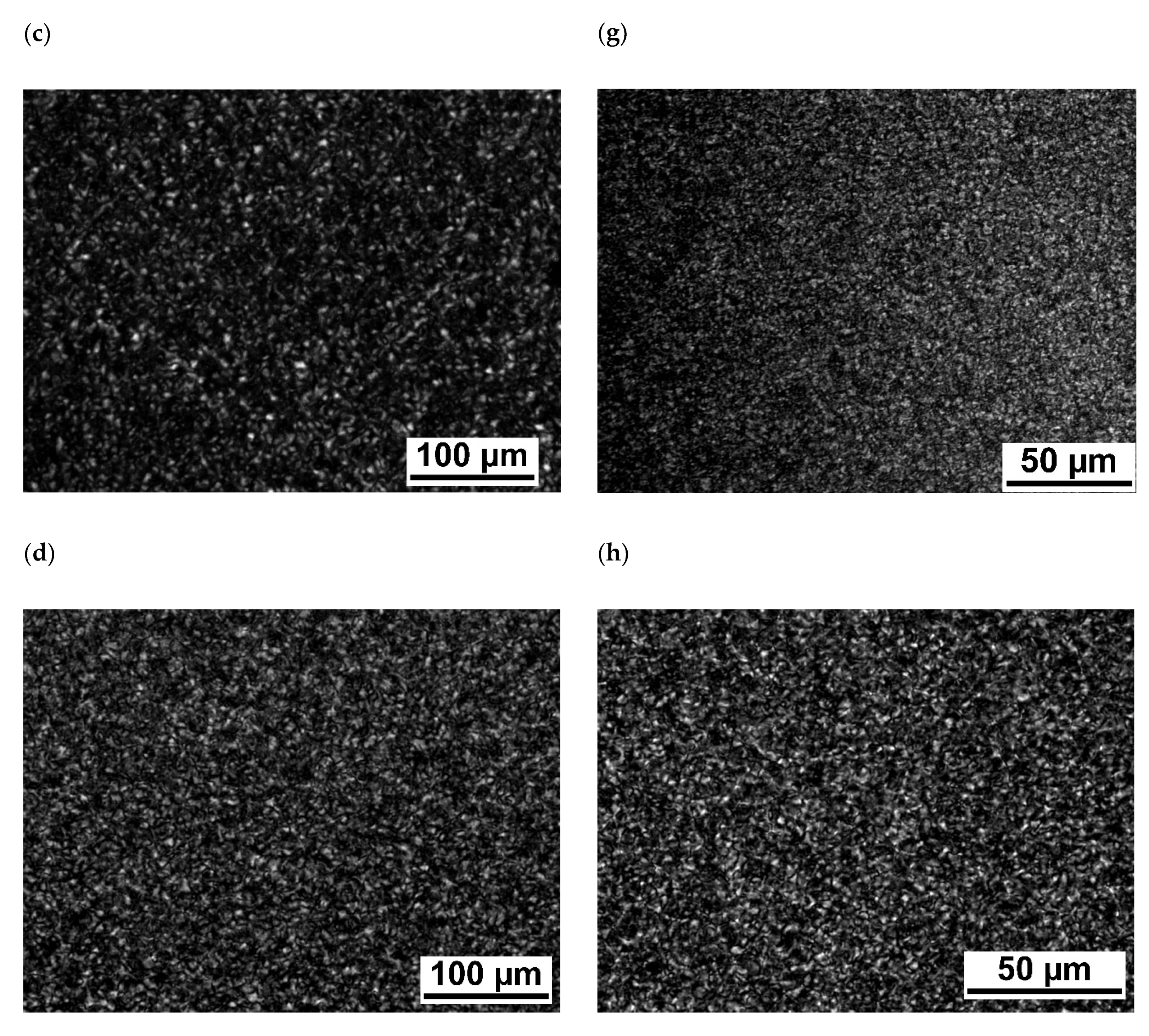

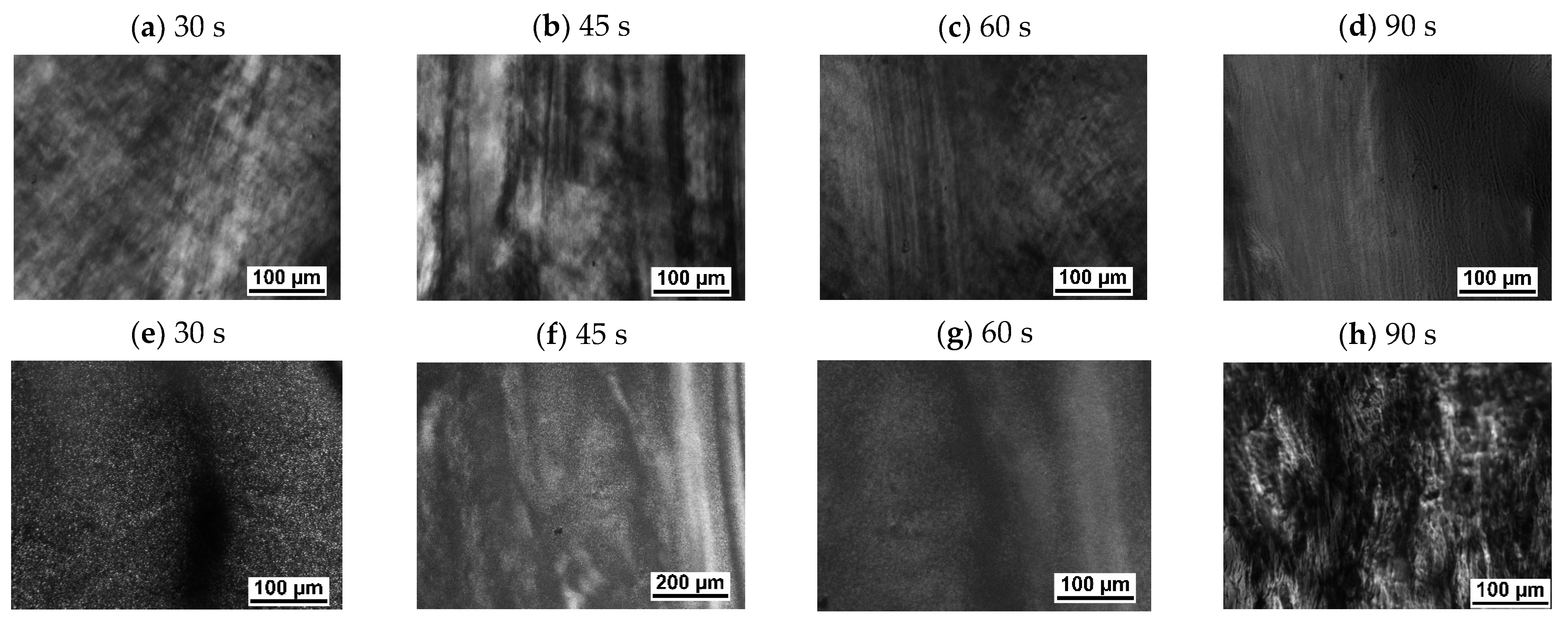



| Shear Rate (s−1) | Tc,PBAT (°C) | Tc,PBASGT (°C) | ||
|---|---|---|---|---|
| 20 °C/min | 10 °C/min | 20 °C/min | 10 °C/min | |
| 0 | 56.5 | 64.6 | 116.0 | 117.0 |
| 100 | 70.0 | 74.2 | 117.5 | 119.9 |
| 200 | 73.1 | 79.0 | 119.5 | 122.1 |
| 300 | 76.3 | 80.1 | 121.5 | 124.7 |
| 400 | 78.0 | 81.3 | 123.5 | 128.2 |
| 600 | 77.4 | 81.0 | 126.0 | 132.0 |
| 800 | - | - | 126.2 | 131.3 |
Publisher’s Note: MDPI stays neutral with regard to jurisdictional claims in published maps and institutional affiliations. |
© 2021 by the author. Licensee MDPI, Basel, Switzerland. This article is an open access article distributed under the terms and conditions of the Creative Commons Attribution (CC BY) license (https://creativecommons.org/licenses/by/4.0/).
Share and Cite
Hosseinnezhad, R. Shear-Induced and Nanofiber-Nucleated Crystallization of Novel Aliphatic–Aromatic Copolyesters Delineated for In Situ Generation of Biodegradable Nanocomposites. Polymers 2021, 13, 2315. https://doi.org/10.3390/polym13142315
Hosseinnezhad R. Shear-Induced and Nanofiber-Nucleated Crystallization of Novel Aliphatic–Aromatic Copolyesters Delineated for In Situ Generation of Biodegradable Nanocomposites. Polymers. 2021; 13(14):2315. https://doi.org/10.3390/polym13142315
Chicago/Turabian StyleHosseinnezhad, Ramin. 2021. "Shear-Induced and Nanofiber-Nucleated Crystallization of Novel Aliphatic–Aromatic Copolyesters Delineated for In Situ Generation of Biodegradable Nanocomposites" Polymers 13, no. 14: 2315. https://doi.org/10.3390/polym13142315
APA StyleHosseinnezhad, R. (2021). Shear-Induced and Nanofiber-Nucleated Crystallization of Novel Aliphatic–Aromatic Copolyesters Delineated for In Situ Generation of Biodegradable Nanocomposites. Polymers, 13(14), 2315. https://doi.org/10.3390/polym13142315





